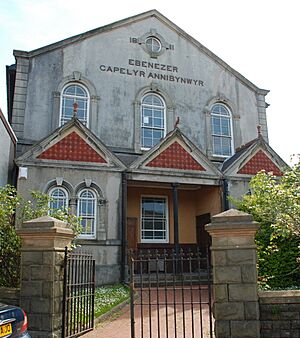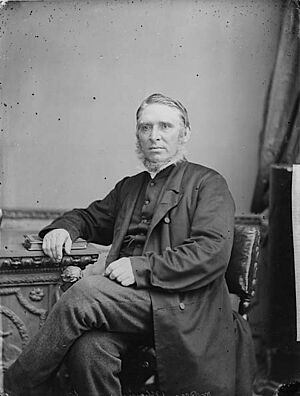Ebenezer Chapel, Trecynon facts for kids
Ebenezer Chapel in Trecynon, Aberdare, was a special kind of church called an Independent (or Congregationalist) chapel. It was one of the very first Independent churches in the Cynon Valley area of Wales. People worshipped there for a long time, from the early 1800s until 2009.
Contents
Early Days of the Chapel
The story of Ebenezer Chapel began in the late 1700s. At that time, people who were Independents and Calvinistic Methodists met together in homes to worship. Sometimes, a minister would visit them.
Around 1799, the two groups decided to worship separately. The Independent group continued to meet at the home of Timothy Davies, which became known as Tŷ'r Capel (Chapel House).
First Worship Place
In 1804, the small group changed a small house on Penypound into a place for worship. They got a special permission for it on October 16, 1804. Ministers like G. Hughes and later Methusalem Jones helped lead the group. Joseph Harrison, who would later become a minister at Ebenezer, joined them around this time.
Building the First Chapel
In 1811, the first chapel building was constructed. Even though land was offered elsewhere, they decided to build it in Trecynon. This area was then called Heolyfelin, which means 'Mill Road'. This name came from the Aberdare Ironworks, a big factory built nearby in 1800.
People said that the church members gathered stones from the common land above Trecynon to build the chapel. The builders were Morgan Shon Morgan, John Richards, and Thomas Philip Richards.
First Minister
In 1813, the church decided to ask David Jones to be their minister. He was officially welcomed on July 29, 1813. However, after three years, there were money problems in the area. Ebenezer couldn't afford to keep a minister, so David Jones moved to another church.
Joseph Harrison's Time (1817–1835)
Joseph Harrison, who started preaching in 1812, became the minister at Ebenezer in 1817. He led the church for the next twenty years. When he started, there were only 26 members.
Growing Church and New Building
But the church grew very quickly! Ebenezer became like a "mother church" to many other Independent churches in the Cynon Valley. Between 1828 and 1830, there was a time of great religious excitement, and more people joined.
The original building became too small. So, in 1829, a larger chapel was built. It could hold about 600 people and cost around £700. By the time Joseph Harrison finished his ministry in 1835, most of the building cost had been paid off.
New Churches Started
During this time, Nebo, Hirwaun was started as a branch of Ebenezer in 1823. In 1835, Joseph Harrison left with fifteen members to start a new church called Salem, Robertstown.
Ministers John Davies and Thomas Rees (1836–1842)
In 1836, Ebenezer and Nebo Chapel invited John Davies to be their minister. He stayed for four years before moving on. After he left, Ebenezer stopped sharing a minister with Nebo.
Thomas Rees's Ministry
Thomas Rees became the minister of Ebenezer from 1840 to 1844. He had a successful time, and the number of members doubled to about 300 in just one year!
More members meant more money for the church. But this led to a disagreement between the minister and some older members. They argued about whether the money should be used to pay the minister more or to pay off the church's debt. Thomas Rees decided to leave Ebenezer in March 1842.
Starting Siloa, Aberdare
Ebenezer didn't have a minister for the next two years. During this time, in 1843, some members left Ebenezer to start a new church called Siloa, Aberdare. One of them was David Price, who became the minister of the new church.
William Edwards's Long Ministry (1844–1884)
William Edwards took over from Thomas Rees. He stayed as minister until he passed away in 1884. During his time, he helped start most of the Independent churches in the Aberdare Valley.
Edwards came from North Wales and had worked in slate quarries before he could afford to study and become a minister. He lived in Trecynon in a home called Meirion Cottage. He started as minister at Ebenezer on July 1 and 2, 1844.
Helping New Churches Grow
Along with David Price from Siloa, Aberdare, William Edwards helped establish new churches in Cwmbach, Mountain Ash, and Aberaman. In 1859, Horeb, Llwydcoed was also started as a branch of Ebenezer. Even with members leaving to join these new churches, Ebenezer's membership kept growing. By 1871, it was larger than ever before.
Chapel Improvements
Ebenezer Chapel was updated in 1852. A building next to it, called 'Ebenezer Hall', was built for the Sunday School. By 1853, Ebenezer had 340 members and 224 children in Sunday School. In 1859, the chapel was rebuilt for a third time. It cost at least £800 and could hold 900 people.
Community Involvement
In 1856, Edwards tried to join the Aberdare Local Board of Health. He wanted to follow the example of Thomas Price, another minister who was the first nonconformist minister to be involved in local government there.
During the 1868 General Election, political meetings were held at Ebenezer to support different candidates. William Edwards later became the President of the Union of Welsh Independents.
Grawys Jones's Time (1885–1925)
The next minister was Grawys Jones. He became minister on September 22 and 23, 1885. Grawys Jones also served for a very long time, forty years, until 1925.
Chapel Renovation
In 1902, the chapel had a big renovation done by Owen Morris Roberts & Son. After the work, special preaching services were held to help pay off the £1,000 debt. Famous preachers like Elfed were guests.
The 1904–1905 Religious Revival
Ebenezer was greatly affected by the 1904–1905 Welsh Revival. This religious movement started near Swansea. Some ministers were worried about how the revival changed church meetings and how it seemed to take attention away from the minister's sermons.
The local newspaper, the Aberdare Leader, was suspicious of the revival from the start. They didn't like the strong emotions it caused.
Evan Roberts's Visit
On Sunday, November 13, the revivalist Evan Roberts held meetings at Bryn Seion chapel in Trecynon. The next evening, Monday, November 14, the revival meetings began at Ebenezer. Roberts spoke, and then one of his female companions started singing a hymn. Soon, everyone joined in. Two more women spoke, and another read from the Bible and prayed.
More meetings were held over the next two days. One lasted for several hours. The meetings were very spontaneous, and women played a big role, which was different from how churches usually ran things.
Newspaper Criticism
Within a week, the editor of the Aberdare Leader became even more critical of the revival. The strong emotions were compared to the excitement during the Boer War a few years earlier. Ebenezer's minister, Grawys Jones, was also criticized for allowing such emotions during meetings he led. Meetings in the town of Aberdare itself were said to be much more organized than those in Trecynon.
The annual preaching meetings at Ebenezer turned into revival meetings and continued late into the night for several evenings.
20th Century and Later History
After four years without a minister, William Morse arrived at Ebenezer in 1929 and stayed for thirty years. During this time, David Emlyn Thomas, who was a Member of Parliament for Aberdare from 1946 to 1954, was a church leader (deacon) at Ebenezer. The number of members fell to 365 by 1945 and to 330 by 1954.
Final Years
Ebenezer's last minister was R.O. Thomas, who served from 1961 to 1986. The chapel continued to be active into the 21st century. However, it stopped being a regular place of worship in April 2009. A small group of the congregation still meets today in the Chapel School Room, which they renamed 'Ebenezer Newydd 2009'.



